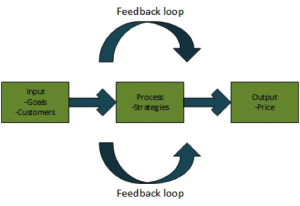 The task of defining the price of a product or service is not an easy one. Companies have to consider several internal and external aspects. Managers hold the opinion that they do not have control over the prices and that the “prices are dictated by the market,” Dolan (2008). However, it is important that the companies have a pricing process based on objectives and customer profiles. Goals and customer profiles are the inputs to be processed through pricing strategies and the outputs should be satisfactory prices for the company and the customers as shown in Figure 1. The feedback loop is also an imperative part of the overall process. After this process is so important that companies consider that “price conveys an image of the organization, affects demand and can be a tool for the organization and target market segmentation”, Wallace (1999).
The task of defining the price of a product or service is not an easy one. Companies have to consider several internal and external aspects. Managers hold the opinion that they do not have control over the prices and that the “prices are dictated by the market,” Dolan (2008). However, it is important that the companies have a pricing process based on objectives and customer profiles. Goals and customer profiles are the inputs to be processed through pricing strategies and the outputs should be satisfactory prices for the company and the customers as shown in Figure 1. The feedback loop is also an imperative part of the overall process. After this process is so important that companies consider that “price conveys an image of the organization, affects demand and can be a tool for the organization and target market segmentation”, Wallace (1999).
According to Talluri & Van Ryzin (2004) it is important to establish a clear pricing strategy when:
- Customers are heterogeneous.
- Demand variability and uncertainty are high.
- Production is rigid allowing for change in prices.
According to Phillips (2005), a good strategy should ensure Price and Revenue Optimization (PRO) in the following main areas:
- For every product
- For every customer segment
- For every channel
 The theory of Six Sigma has been extremely useful for several companies as a pricing tool. According to Sodhi (2008) the theory consists of five steps: define, measure, analyze, improve and control.
The theory of Six Sigma has been extremely useful for several companies as a pricing tool. According to Sodhi (2008) the theory consists of five steps: define, measure, analyze, improve and control.
1. Define: In this stage it is important to define the scenario, objectives and examine the process so that the problem is clear and can be acted on directly.
2. Measure: This stage is the preparation for analysis where the necessary information as evidence of the problem encountered is collected and all items related to the pricing process such as sales, finance, marketing, etc. are discussed.
3. Analyze: After having documented all the information necessary to apply tools and techniques, analysis would involve investigating the causes of the problem and exploration of opportunities for improvement.
4. Improve: As a result of the analysis, improvement would imply taking steps to amend the existing process through the elimination of inappropriate prices and creation of an improved and appropriate process. It is important to develop alternatives to improve and to develop a new map of the process taking into account its benefits.
5. Control: Finally, it is important to develop controls that maintain the process under favorable conditions in line with the goals. This would mean establishing indicators in order to monitor the process and key moments and also to review the process with the executives as well as to give the assurance that the process is progressing in the right direction as per the objectives.
In conclusion, it is important that this process be conducted in the best way and the whole organization be part of it. Recognizing that the pricing process is part of the whole organization, routines and processes is key to success in prices (Johansson, 2011).
References:
- Dolan, R. (2008) How do you know when the Price is rigth? Harward business review on pricing. (pp. 1-26). Harvard Business School Publishing, Boston.
- Johansson, M. (2011). Pricing strategies and pricing capabilities. Institute of Economic Research. Lund University, Sweden. Available at: http://www.palgrave-journals.com/rpm/journal/v11/n1/pdf/rpm201142a.pdf
- Phillips, R. (2005) Pricing and Revenue Optimzation. Stanford University Press. Stanford, California.
- Sodhi, M., Sodhi, N. (2008) Six Sigma Pricing. Harward Business review on pricing. (pp. 133-154). Harward Business School Publishing, Boston.
- Talluri, K., Van Ryzin, G. (2004) Revenue Management Under a General Discrete Choice Model of Consumer Behavior. Department of Economics and Business, Barcelona. Columba University, New York. Available at: http://orsnz.org.nz/conf36/papers/Talluri.pdf
- Wallace, R. (1999). Pricing Strategy. Information Outlook. Money Matters.
